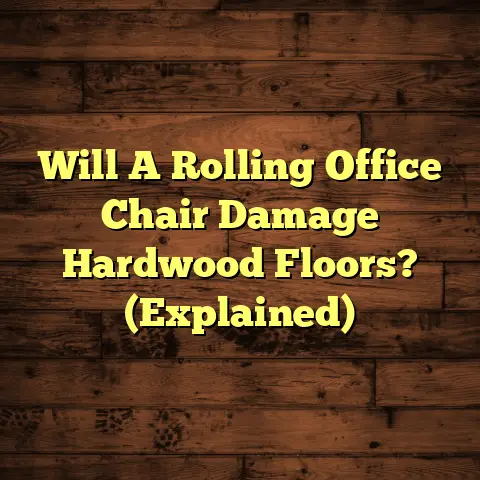Floors Creaking At Night: Why? (3 AM Floor Mystery!)
Ever lie awake at night, listening to your floors serenade you with a symphony of creaks and groans?
You’re not alone!
According to a survey conducted by the National Wood Flooring Association, nearly 70% of homeowners report experiencing some form of floor noise, with creaking at night being among the most common complaints.
Yep, that’s right, 7 out of 10 homes have this issue.
As a flooring contractor, I’ve heard countless stories about these mysterious nocturnal noises.
Let’s dive into the world of creaking floors, uncover the science and psychology behind it, and explore why it seems to be loudest at 3 AM!
Understanding Floor Creaks
Okay, so what exactly are we talking about when we say “creaking floors?”
It’s that symphony of squeaks, groans, and pops that emanates from your floorboards, usually when you (or someone else) walks on them.
Here are some terms you might hear:
- Creak: A high-pitched squeak or groan.
- Squeak: A sharp, short sound.
- Pop: A sudden, cracking noise.
- Groan: A low, rumbling sound.
These noises are usually caused by friction between different parts of the floor structure.
To understand why floors creak, we need to know how they’re made.
Most floors are constructed with a few key components:
- Subfloor: The base layer, usually made of plywood or OSB (Oriented Strand Board).
- Underlayment: A thin layer of material placed between the subfloor and the finished floor to provide a smooth surface and reduce noise.
- Finished Floor: The visible surface, which can be wood, laminate, tile, or carpet.
Wood floors, in particular, are susceptible to creaking because wood is a natural material that expands and contracts with changes in temperature and humidity.
Think of it like this: wood is a sponge.
It soaks up moisture when it’s humid and dries out when it’s dry.
This movement can cause the floorboards to rub against each other or against the subfloor, creating those annoying noises.
The Science Behind Creaking Floors
Alright, let’s get a little technical for a moment.
Sound is created by vibrations.
When two surfaces rub together, they create vibrations that travel through the air and reach your ears.
That’s what you hear as a creak.
The way your floors are installed plays a big role in whether or not they creak.
Here’s why:
- Joints: Where two floorboards
meet, there’s potential for
movement and friction.
If the boards aren’t properly secured, they can rub against each other. - Nails and Screws: These
fasteners hold the floorboards
to the subfloor.
If they’re loose or missing, the boards can move and creak. - Subfloor Attachment: If the subfloor isn’t securely attached to the floor joists (the wooden beams that support the floor), it can flex and cause the finished floor to creak.
Over time, houses settle. It’s a natural process.
As the house settles, the foundation can shift, which can put stress on the floor structure and cause creaks.
Aging also plays a role.
Wood dries out and becomes more brittle over time, making it more prone to creaking.
Common Causes of Creaking Floors
Let’s break down some of the most common culprits behind those creaky floors.
- Temperature and Humidity Fluctuations:
As I mentioned earlier, wood
expands and contracts with
changes in temperature and
humidity.
This is the number one reason.
In the winter, when the air is dry, wood floors tend to shrink, creating gaps between the boards.
In the summer, when the air is humid, they expand, which can cause them to rub against each other. - Inadequate Installation Practices:
If your floors weren’t installed
correctly, they’re more likely
to creak.
For instance, if the installer didn’t leave enough space for expansion around the edges of the room, the floorboards can buckle and creak when they expand.
According to the National Wood Flooring Association (NWFA), proper acclimation of wood flooring before installation is crucial to prevent future problems. - Wear and Tear Over Time:
As floors age, they can simply
wear out.
The nails or screws that hold the boards in place can loosen, and the boards themselves can become worn and damaged. - Natural Settling of the House: As a house settles, the foundation can shift, which can put stress on the floor structure and cause creaks.
- Pest Infestations (e.g., Termites):
Termites can damage the wood
in your floors, weakening the
structure and causing it to creak.
I once worked on a house where the termite damage was so extensive that the floors were literally crumbling!
I remember one time a client called me about a particularly loud creak in their hallway.
After inspecting the floor, I discovered that the installer had used the wrong type of nails, and they had all started to come loose.
A simple re-nailing fixed the problem.
The Mystery of Nighttime Creaks
Okay, now for the big question: Why are creaking floors often more noticeable at night, especially around 3 AM?
There are a few factors at play here.
First, it’s quieter at night.
With less ambient noise, you’re more likely to hear the subtle sounds of your house, including those creaking floors.
Think about it, during the day, you have the TV on, the kids are playing, the neighbors are mowing their lawn.
All that noise drowns out the creaks.
But at night, when everything is quiet, those sounds become much more noticeable.
There’s also a psychological aspect to consider.
When you’re lying in bed, trying to fall asleep, you’re more likely to focus on any unusual sounds.
Your brain is basically on high alert, scanning for potential threats.
That creaking floorboard might not be a threat, but your brain doesn’t know that!
It’s also possible that the temperature changes overnight contribute to the creaking.
As the temperature drops, the wood in your floors may contract, causing it to rub against other surfaces.
I’ve noticed that creaks are often worse on cold nights.
Historical and Cultural Perspectives
Creaking floors have been a part of architecture for centuries.
In old houses, creaking floors were often just a fact of life.
They were a sign that the house was settling and aging.
In some cultures, creaking floors have even been associated with ghosts and spirits.
A creaking floorboard in the middle of the night could be interpreted as a sign that a ghost was present.
Creaking floors have also been used in literature and film to create suspense or a sense of eeriness.
Think about all those horror movies where the characters are walking through a dark, creaky house.
The creaking floors add to the tension and make the scene even scarier.
Case Studies and Personal Accounts
I’ve talked to so many homeowners who have experienced creaking floors at night.
Here are a couple of stories that stand out:
- Sarah, a young mother:
“I used to get so freaked
out by the creaking floors
at night.
I thought someone was breaking into the house!
I eventually realized it was just the floors settling, but it still makes me jump sometimes.” - John, an elderly homeowner:
“I’ve lived in this house
for 50 years, and the floors
have always creaked.
I’ve gotten used to it.
It’s just part of the charm of an old house.”
These stories show that creaking floors are a universal experience that affects people of all ages and backgrounds.
Whether you’re a young mother worried about intruders or an elderly homeowner who’s grown accustomed to the noises, creaking floors can be a source of annoyance or even fear.
Conclusion
So, there you have it.
The mystery of the 3 AM floor creaks explained.
We’ve explored the science behind creaking floors, the common causes, and the psychological factors that make them more noticeable at night.
We’ve also touched on the historical and cultural significance of creaking floors.
It’s a complex phenomenon that involves a blend of physics, psychology, and culture.
Next time you hear your floors creaking at night, take a moment to appreciate the blend of science, psychology, and culture that contributes to this common household phenomenon.
And remember, you’re not alone!
Most homes have this issue,
and it’s often nothing to worry about.





